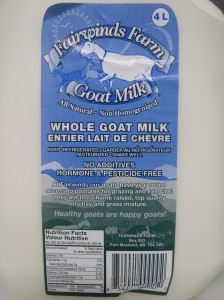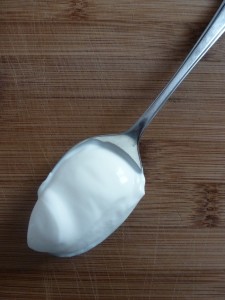Baby’s first fluid gel! Fluid gels are an entire category of sauces that are ubiquitous in contemporary cuisine. I avoided them for years, another example of my old disdain for things I considered “modernist”.
Flipping through the Eleven Madison Park cookbook I saw several dishes in which yogurt was drawn across the plate in perfectly smooth lines. I had recently used yogurt on a lamb dish, and not only did it not look smooth, it also tended to weep a bit of moisture when put on a warm plate. I finally discovered that the yogurt component in these EMP dishes were actually dairy fluid gels made with agar agar. While the yogurt has to be somewhat diluted with milk or … Continue reading.
 My ideal yogurt is Greek yogurt, which is thick, rich, flavourful, and made of sheep’s milk. Unable to find whole sheep’s milk, I’m experimenting with goat’s milk from Fairwinds Farm of Fort Macleod, Alberta, as it is fattier (and just more Greek) than cow’s milk.
My ideal yogurt is Greek yogurt, which is thick, rich, flavourful, and made of sheep’s milk. Unable to find whole sheep’s milk, I’m experimenting with goat’s milk from Fairwinds Farm of Fort Macleod, Alberta, as it is fattier (and just more Greek) than cow’s milk.
There are two ways to culture yogurt at home. The first is to add a small amount of commercial yogurt containing active cultures to milk. The second is to use pure bacterial cultures. Regardless of which method you use, the process is basically the same.
Danlac Starter Kit
I eventually want to make cheese with pure bacterial cultures. I contacted Danlac in Airdrie, and ordered a starter kit containing several doses of rennet and cultures … Continue reading.
 Crème fraîche is similar to sour cream. In fact, they are made by the same process: inoculating dairy with a bacterial culture that converts lactose to lactic acid, which in turn coagulates the proteins in the dairy and thickens the mixture.
Crème fraîche is similar to sour cream. In fact, they are made by the same process: inoculating dairy with a bacterial culture that converts lactose to lactic acid, which in turn coagulates the proteins in the dairy and thickens the mixture.
The main difference between the two products is that crème fraîche is cultured whole cream (about 30% milk fat) while sour cream is made from leaner dairy products (usually about 15% fat). The added fat in crème fraîche gives it two advantages over sour cream. First, it has a more luxurious texture. Second, the fat tempers the acidity, making for a subtler and more rounded flavour.
Making Crème Fraîche at Home
Fresh dairy naturally contains the bacteria that would, … Continue reading.
I think as children most of us were taken to historical sites like Fort Edmonton to learn how the settlers made wool and horseshoes and butter. Even so, I’ll start at the beginning.
You make butter by agitating cream.
It works like this. The fat in cream is in tiny globs, each covered with a membrane that prevents the fat globs from joining together. When you agitate cream, you break these coverings, releasing the fat globs, which all rush out to join their fatty brethren and form a solid mass of butter.
To commence butter-production, fill your container half way with heavy cream. Add a pinch of salt, secure the lid, and start shaking. You don’t have to strain yourself, … Continue reading.
The personal website of Edmonton chef Allan Suddaby


